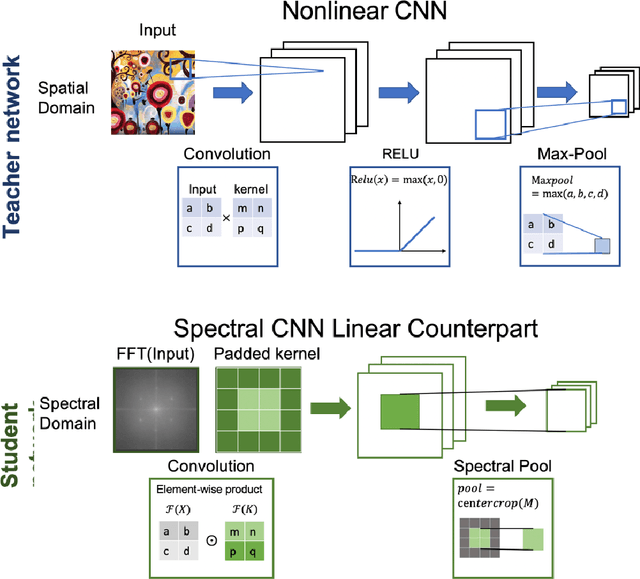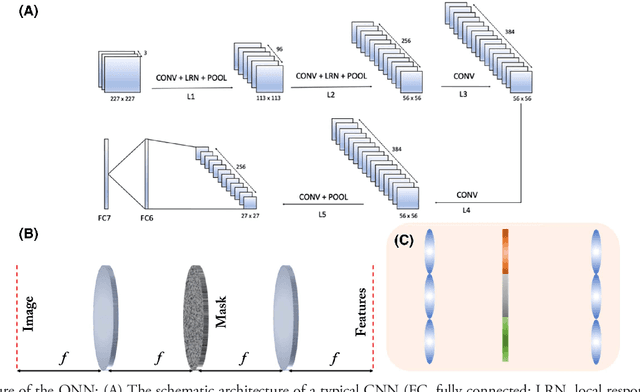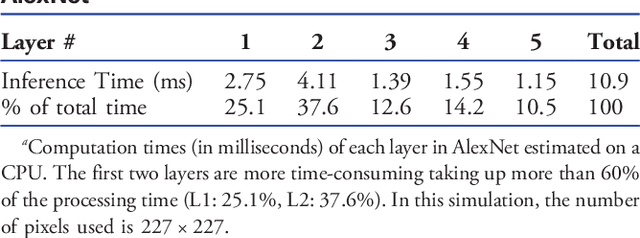Shane Colburn
Computed tomography using meta-optics
Nov 13, 2024Abstract:Computer vision tasks require processing large amounts of data to perform image classification, segmentation, and feature extraction. Optical preprocessors can potentially reduce the number of floating point operations required by computer vision tasks, enabling low-power and low-latency operation. However, existing optical preprocessors are mostly learned and hence strongly depend on the training data, and thus lack universal applicability. In this paper, we present a metaoptic imager, which implements the Radon transform obviating the need for training the optics. High quality image reconstruction with a large compression ratio of 0.6% is presented through the use of the Simultaneous Algebraic Reconstruction Technique. Image classification with 90% accuracy is presented on an experimentally measured Radon dataset through neural network trained on digitally transformed images.
Knowledge Distillation Circumvents Nonlinearity for Optical Convolutional Neural Networks
Feb 26, 2021



Abstract:In recent years, Convolutional Neural Networks (CNNs) have enabled ubiquitous image processing applications. As such, CNNs require fast runtime (forward propagation) to process high-resolution visual streams in real time. This is still a challenging task even with state-of-the-art graphics and tensor processing units. The bottleneck in computational efficiency primarily occurs in the convolutional layers. Performing operations in the Fourier domain is a promising way to accelerate forward propagation since it transforms convolutions into elementwise multiplications, which are considerably faster to compute for large kernels. Furthermore, such computation could be implemented using an optical 4f system with orders of magnitude faster operation. However, a major challenge in using this spectral approach, as well as in an optical implementation of CNNs, is the inclusion of a nonlinearity between each convolutional layer, without which CNN performance drops dramatically. Here, we propose a Spectral CNN Linear Counterpart (SCLC) network architecture and develop a Knowledge Distillation (KD) approach to circumvent the need for a nonlinearity and successfully train such networks. While the KD approach is known in machine learning as an effective process for network pruning, we adapt the approach to transfer the knowledge from a nonlinear network (teacher) to a linear counterpart (student). We show that the KD approach can achieve performance that easily surpasses the standard linear version of a CNN and could approach the performance of the nonlinear network. Our simulations show that the possibility of increasing the resolution of the input image allows our proposed 4f optical linear network to perform more efficiently than a nonlinear network with the same accuracy on two fundamental image processing tasks: (i) object classification and (ii) semantic segmentation.
An Optical Frontend for a Convolutional Neural Network
Jan 14, 2019



Abstract:The parallelism of optics and the miniaturization of optical components using nanophotonic structures, such as metasurfaces present a compelling alternative to electronic implementations of convolutional neural networks. The lack of a low-power optical nonlinearity, however, requires slow and energy-inefficient conversions between the electronic and optical domains. Here, we design an architecture which utilizes a single electrical to optical conversion by designing a free-space optical frontend unit that implements the linear operations of the first layer with the subsequent layers realized electronically. Speed and power analysis of the architecture indicates that the hybrid photonic-electronic architecture outperforms sole electronic architecture for large image sizes and kernels. Benchmarking of the photonic-electronic architecture on a modified version of AlexNet achieves a classification accuracy of 87% on images from the Kaggle Cats and Dogs challenge database.
 Add to Chrome
Add to Chrome Add to Firefox
Add to Firefox Add to Edge
Add to Edge